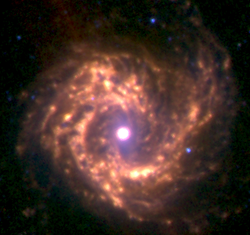Top Qs
Timeline
Chat
Perspective
Messier 61
Galaxy in the constellation Virgo From Wikipedia, the free encyclopedia
Remove ads
Messier 61 (also known as M61, NGC 4303, or the Swelling Spiral Galaxy) is an intermediate barred spiral galaxy in the Virgo Cluster of galaxies. It was first discovered by Barnaba Oriani on May 5, 1779, six days before Charles Messier discovered the same galaxy. Messier had observed it on the same night as Oriani but had mistaken it for a comet.[5] Its distance has been estimated to be 45.61 million light years from the Milky Way Galaxy. It is a member of the M61 Group of galaxies, which is a member of the Virgo II Groups, a series of galaxies and galaxy clusters strung out from the southern edge of the Virgo Supercluster.[6]
Remove ads
Properties
M61 is one of the largest members of Virgo Cluster, and belongs to a smaller subgroup known as the S Cloud.[7][8] The morphological classification of SAB(rs)bc[3] indicates a weakly-barred spiral (SAB) with the suggestion of a ring structure (rs) and moderate to loosely wound spiral arms.[9] It has an active galactic nucleus[10] and is classified as a starburst galaxy containing a massive nuclear star cluster with an estimated mass of 1 million solar masses (M☉) and an age of 4 million years,[11] as well as a central candidate supermassive black hole weighing around 5 million M☉.[12] It cohabits with an older massive star cluster as well as a likely older starburst.[11] Evidence of significant star formation and active bright nebulae appears across M61's disk.[13] Unlike most late-type spiral galaxies within the Virgo Cluster, M61 shows an unusual abundance of neutral hydrogen (H I).[14]
Remove ads
Supernovae
Eight supernovae have been observed in M61, making it one of the most prodigious galaxies for such cataclysmic events.[15][16][5] These include:
- SN 1926A (Type II, mag. 14) was discovered by Max Wolf and Karl Wilhelm Reinmuth on 9 May 1926.[17][18][19]
- SN 1961I (Type II, mag. 13) was discovered by Milton Humason on 3 June 1961.[20][21][22]
- SN 1964F (Type II, mag. 14) was discovered by Leonida Rosino on 30 June 1964.[23][24]
- SN 1999gn (Type II, mag. 16) was discovered by Alessandro Dimai on 17 December 1999.[25][26]
- SN 2006ov (Type II, mag. 14.9) was discovered by Kōichi Itagaki on 24 November 2006.[27][28][29]
- SN 2008in (Type II, mag. 14.9) was discovered by Kōichi Itagaki on 26 December 2008.[30][31]
- SN 2014dt (Type Ia-pec, mag. 13.6) was discovered by Kōichi Itagaki on 29 October 2014.[32][33]
- SN 2020jfo (Type II, mag. 16.01) was discovered by the Zwicky Transient Facility on 6 May 2020.[34]
Remove ads
Gallery
- M61 (with NGC 4301 in upper left) imaged by the Vera C. Rubin Observatory
- Spiral galaxy Messier 61 is aligned face-on towards Earth.[35]
- Messier 61 image using data from Hubble's Wide Field Camera 2
- Amateur Image of Messier 61 Showing Supernova 2008in on April 16, 2009
- Infrared image of M61 taken by the Spitzer Space Telescope
- Messier 61 with SN2020jfo (Supernova) observed on May 15, 2020
- M61 galaxy image that incorporates data from not only Hubble, but also the FORS camera at the European Southern Observatory’s Very Large Telescope
See also
References
External links
Wikiwand - on
Seamless Wikipedia browsing. On steroids.
Remove ads








